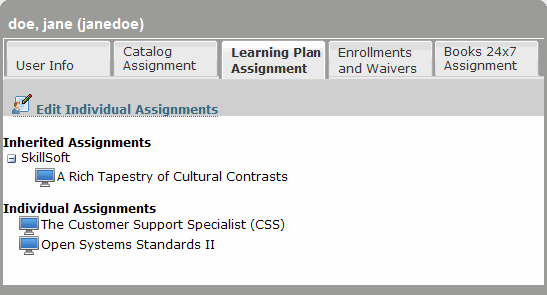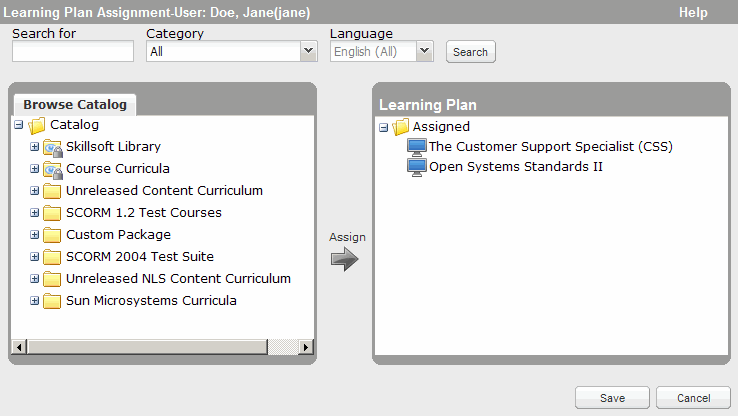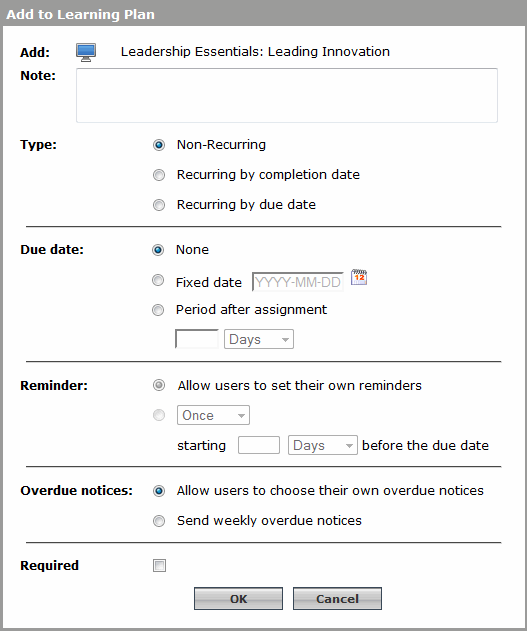Note: If your organization has enabled Skillport's recurrence feature, use the To add a recurring asset to the learning plan for a group or user drop-down. For more information about recurring assets for compliance content, see Recurring Assets (Compliance) and Existing Completions for Compliance Content.
 To add an asset to the learning plan for a group or user
To add an asset to the learning plan for a group or user
All Learning Plan assignments for the user or group display:

Note: While you can browse the inherited Learning Plan assignments for the user or group, to modify these, you must modify the assignments of the parent group.
The Learning Plan Assigner page displays.

Note: To add a specific section of a book or a specific topic in a course, you must move your mouse over the asset's title, and then click the Show Details link that displays. Next, click ![]() to expand the relevant chapter or lesson, and click the Add link that appears beside the section or topic, as shown in the example below for a section.
to expand the relevant chapter or lesson, and click the Add link that appears beside the section or topic, as shown in the example below for a section.
The Add to Learning Plan dialog box displays.

Depending on the configuration of your site, one or more of the settings shown in the image above might not be available.
Note: If you set a reminder, you must also enter the number of days before the asset's due date to send the initial or one-time reminder email. The reminder e-mail contains direct links to the asset itself and to its details page.
Note: This setting does not affect the behavior of application; it is used for reporting. It differentiates required assets from optional ones.
 To add a recurring asset to the learning plan for a group or user
To add a recurring asset to the learning plan for a group or user
Note: The types of assets you can restart include courses, test preps, SkillSims, custom content, practice labs, and recorded Dialogue sessions. For more information, see Recurring Assets (Compliance).
All assignments for the user or group display:

Note: While you can browse the inherited learning plan assignments for the user or group, to modify these, you must modify the learning plan assignments of the parent group.
The Learning Plan Assigner page displays.

 add a specific book section or course topic to the Assigned folder.
add a specific book section or course topic to the Assigned folder.A Show Details link displays.
A list of the book sections or course topics display.
An Add link displays:

The Add to Learning Plan dialog box displays.
The Add to Learning Plan dialog box displays.

Note: Depending on the configuration of your site, one or more of the settings shown in the image above might not be available.
 Recurring by completion date
Recurring by completion dateThis date is the first time the assigned content will be due for completion. Enter a numeric value and select Days, Weeks or Years from the drop-down list. (For example, if you assign an asset on May 1, and enter the Initial Due Date as 30 Days, the assignment is due on May 31.)
This becomes the date from which the reassignment value is based. Enter a numeric value and select Days, Weeks or Years from the drop-down list. For example, if you set the Recurring Due Date to May 1, 2014 and the user completes the asset on February 1, 2014 (earlier than expected), the next due date remains May 1, 2015.
The time frame set here determines when the user can access the content. If, for example, a course repeats yearly, you may not want a user to take the course on December 31, 2014 and again on January 1, 2015 to fulfill the requirement. The Open Window option allows you to specify when you want the course available to the user for training.
Note: If you set a reminder, users cannot change it. However, if you allow users to set their own reminders, you can override them with a reminder that you set (which also cannot be changed by users).
Note: This setting does not affect the behavior of application; it is used for reporting. It differentiates required assets from optional ones.
 Recurring by due date
Recurring by due dateThis date is the first time the assigned content will be due for completion. Enter a numeric value and select Days, Weeks or Years from the drop-down list. (For example, if you assign content on May 1, and enter the Initial Due Date as 30 Days, the assignment is due on May 31.)
Reassign every x Days/Weeks/Years based on recurring due date: Enter the number of days, weeks or years when you want this assignment to reassign (reappear) in the user's learning plan. Enter a numeric value and select Days, Weeks or Years from the drop-down list.
Recurring Due Date: This becomes the date from which the reassignment value is based. Enter a numeric value and select Days, Weeks or Years from the drop-down list. For example, if you set the Recurring Due Date to May 1, 2014 and the user completes the asset on February 1, 2014 (earlier than expected), the next due date remains May 1, 2015.
Note: For example, on May 1, 2014, you set the Initial Due Date to 30 days after the assignment, making the asset due on May 31, 2014. If the Recurring Due Date is set to May 31, 2015 (because you want the user to take the course every year), and you set the Reassign every... field to 180 Days, then the content displays in the learning plan on November 27, 2014 and the next time the content is due is the date set in the Recurring Due Date field.
The time frame set here determines when the user can access the content. If, for example, a course repeats yearly, you may not want a user to take the course on December 31, 2014 and again on January 1, 2015 to fulfill the requirement. The Open Window option allows you to specify when you want the course available to the user for training.
Note: If you set a reminder, users cannot change it. However, if you allow users to set their own reminders, you can override them with a reminder that you set (which also cannot be changed by the user).
Note: If the content is a course, for Overdue notices, select one of the following:
- users can choose whether to receive overdue notices by email, or
- overdue notices should be sent (and users should not be given the choice to receive these notices)
Note: Once a recurring assignment is created, you cannot change the Type. Additionally, if you change the Due Date, Initial Due Date, Recurrence period (Period after assignment), or Open Window settings, you may affect the learner's ability to continue gaining progress, or cause existing completions to expire. If you need to change the assignment Type or any dates associated with the assignment, create a new assignment with the desired settings.